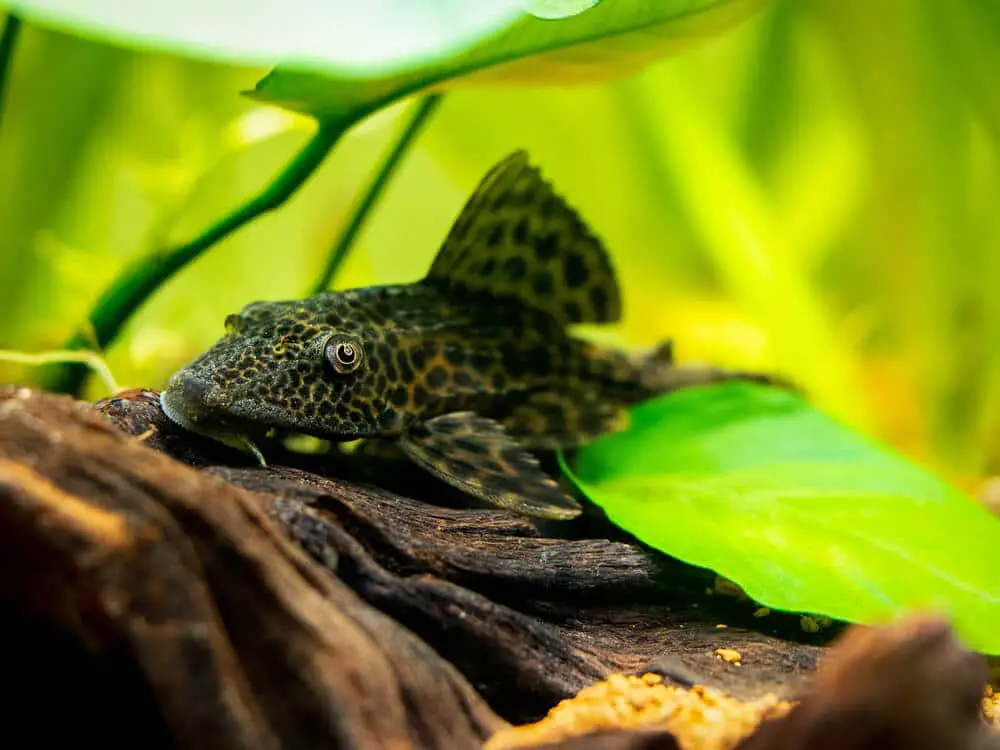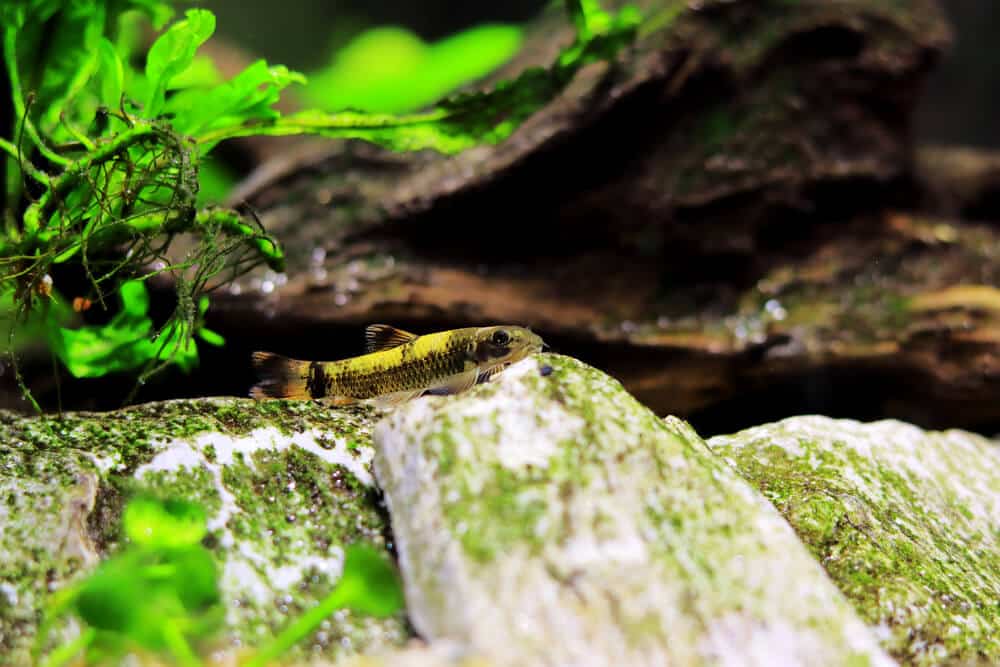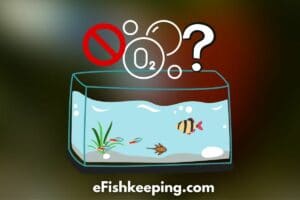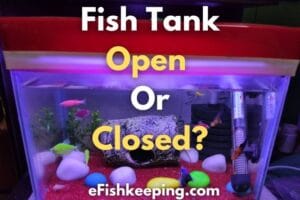Ever found yourself staring at the aquarium and noticing a sudden outbreak of unsightly algae?
Then don’t worry, you’re not alone! Algae overgrowth is a very common problem with fish tanks.
And while there are numerous ways to address algae problems in a tank, algae eaters can be a fantastic solution. But this raises the question:
How many algae eaters should you have in your fish tank?
Generally speaking, a single pleco fish – a popular algae eater – requires at least 15-30 gallons of tank space. As for other algae eaters: you can keep 5-6 Otocinclus catfish per 10 gallons of tank space; a Siamese algae eater needs 20 gallons of tank space; each nerite snail requires 5 gallons of tank space; and 2 gallons of tank space is sufficient for each shrimp.

Most algae eaters are typically peaceful, and they don’t usually consume other fish unless the fish is sick or already dead. As a result, you can keep multiple algae eater species together without any issues.
Keep reading until the end, as I’ll be sharing suitable algae eater combinations, how many you should have in your tank, and more information about these helpful creatures.
Number Of Algae Eaters In A 5-10 Gallon Tank
First up, let’s consider the otocinclus catfish. These little guys are perfect for smaller tanks, and you can have about 2-3 of them in a 5-10 gallon tank. They’re peaceful, get along well with other fish, and love munching on algae.
Next, we have nerite snails. These slow-moving, algae-gobbling friends are ideal for small tanks. You can comfortably house 1-2 nerite snails in a 5-10 gallon tank. They’re great at cleaning up algae and happily coexist with other tank inhabitants.
Now, let’s talk about shrimp. Amano and cherry shrimp are fantastic algae eaters and perfect for small tanks. You can have around 2-5 shrimp in a 5-10 gallon tank, depending on the species. They’re not only great at tackling algae, but they also add a dash of color to your tank.
As for tank mates, some smaller, peaceful freshwater fish can coexist with these algae eaters in a 5-10 gallon tank. Think about adding some guppies, neon tetras, or endlers to create a vibrant and harmonious environment.
So, what’s the ideal combination for a 5-10 gallon tank?
You could go with 2-3 otocinclus catfish, 1-2 nerite snails, and 2-5 shrimp. Or, mix it up with 1 otocinclus, 2 nerite snails, and 3 shrimp. There’s no one-size-fits-all answer, so feel free to experiment and find the perfect balance for your tank.
Just remember, when introducing new algae eaters, always consider the individual needs of each species and ensure you have enough space, hiding spots, and food to keep every fish in the tank happy and healthy!
Number Of Algae Eaters In A 20-30 Gallon Tank
First, let’s talk about the possible algae eater combinations for a 20-30 gallon tank:
- One Pleco: These big guys do a great job munching on algae, but because they grow quite large, you should only keep one in a tank of this size.
- 4-6 Otocinclus Catfish: These small, schooling fish are fantastic algae eaters. You can keep about 5-6 of them per 10 gallons, so you could have up to 12 in a 30-gallon tank!
- One Siamese Algae Eater: These fish are quite active and need a minimum of 20 gallons of tank space, so you can comfortably have one in your tank.
- 4-6 Nerite Snails: Each nerite snail requires 5 gallons of tank space, so you could have up to 6 in a 30-gallon tank.
- 10-15 Shrimp: With 2 gallons of tank space needed for each shrimp, you could have up to 15 shrimp in a 30-gallon tank.
Now, let’s discuss some possible combinations:
- One Pleco and 4-6 Nerite Snails
- 4-6 Otocinclus Catfish and 10-15 Shrimp
- One Siamese Algae Eater, 4-6 Nerite Snails, and 10-15 Shrimp
These combinations should help keep your tank free of algae while maintaining a good balance of different species.
As for the fish that are compatible with these algae eaters, here are some great options for your 20-30 gallon tank:
- Tetras: These small, colorful fish are peaceful and get along well with most algae eaters.
- Rasboras: These schooling fish are easygoing and won’t bother your algae eaters.
- Guppies: Known for their bright colors and lively nature, guppies are a great addition to any community tank.
- Corydoras Catfish: These bottom dwellers are peaceful and friendly, making them a perfect match for your algae eaters.These are my favorite fish of all time and I still have them in one of our home fish tanks!
- Mollies: These adaptable fish are usually peaceful and can coexist with a variety of tank mates, including algae eaters.
Number Of Algae Eaters In A 40-50 Gallon Tank
For a 40-50 gallon tank, you’ve got plenty of options when it comes to algae eaters.
To make it easy for you, I’ve come up with a handy table that shows different combinations of algae eaters and some rough numbers you can consider while adding them to your tank.
| Combination | Number of Each Algae Eater |
| Pleco and Otocinclus | 1 Pleco, 10-12 Otocinclus |
| Pleco and Nerite Snails | 1 Pleco, 8-10 Nerite Snails |
| Pleco and Shrimp | 1 Pleco, 15-20 Shrimp |
| Siamese and Otocinclus | 2 Siamese, 8-10 Otocinclus |
| Siamese and Nerite Snails | 2 Siamese, 6-8 Nerite Snails |
| Siamese and Shrimp | 2 Siamese, 18-22 Shrimp |
| Otocinclus and Nerite Snails | 16-20 Otocinclus, 4-6 Nerite Snails |
| Otocinclus and Shrimp | 16-20 Otocinclus, 8-12 Shrimp |
| Nerite Snails and Shrimp | 12-14 Nerite Snails, 10-12 Shrimp |
Remember that the tank space recommendations I shared earlier are just general guidelines. Your tank’s unique ecosystem and its ability to handle bioload (waste generated inside the tank by the creatures) might allow for a few more or fewer fish than suggested.
For instance, if you do more frequent water changes, and you have live plants, then your tank can easily handle a bit more algae eaters. So, always consider your specific tank conditions when adding new finned friends!
Now that you know some possible algae eater combinations, you might be wondering about other fish that can live peacefully with these algae eaters in your 40-50 gallon tank.
Here’s a list of some freshwater aquarium fish that can coexist with the algae eaters mentioned above:
- Guppies
- Tetras (e.g., Neon Tetras, Cardinal Tetras, Glowlight Tetras)
- Mollies
- Platies
- Corydoras Catfish
- Rasboras
- Dwarf Gouramis
Keep in mind that each fish species has its own requirements for tank size, water temperature, and other parameters. So, before adding any fish to your tank, make sure you research their specific needs and compatibility with your current setup.
Number Of Algae Eaters In A 55-75 gallon
So, how many algae eaters should you have in your 55-75 gallon tank? Well, it depends on the type of algae eater you choose. Let’s take a look at some of the options:
- Pleco fish: As I mentioned earlier, plecos are a popular algae eater. They require at least 15-30 gallons of tank space per fish. So, for a 55-75 gallon tank, you could have one or two plecos.
- Otocinclus catfish: These little guys are great at eating algae, and you can keep 5-6 of them per 10 gallons of tank space. So, for a 55-75 gallon tank, you could have around 27 otocinclus catfish.
- Siamese algae eater: These fish need 20 gallons of tank space each. So, for a 55-75 gallon tank, you could have 2-3 Siamese algae eaters.
- Nerite snail: Each nerite snail requires 5 gallons of tank space. So, for a 55-75 gallon tank, you could have 11-15 nerite snails.
- Shrimp: 2 gallons of tank space is sufficient for each shrimp. So, for a 55-75 gallon tank, you could have 27-37 shrimp.
Now that we know how many of each type of algae eater we can have in the tank, let’s talk about suitable combinations. You could have one or two plecos along with a group of otocinclus catfish and a couple of Siamese algae eaters. Alternatively, you could have a mix of nerite snails and shrimp.
It’s important to note that not all freshwater aquarium fish are suitable to be kept in a 55-75 gallon tank with algae eaters. You want to make sure that the fish you choose are compatible with the algae eaters and won’t become prey.
- Tetras (such as neon tetras, black skirt tetras, or cardinal tetras)
- Guppies
- Corydoras (also known as cory cats)
- Swordtails
- Platies
- Mollies
- Cherry barbs
- Harlequin rasboras
- Rainbow fish
- Zebra danios
Do You Really Need An Algae Eater?
Algae eaters can be super helpful, but sometimes, they might not be necessary. Let’s dive in and explore when and when ‘s not needed to add these helpful buddies to your tank.
So, why are algae eaters a big help in aquariums?
First, they’re like the cleanup crew of your fish tank. They munch on the algae, keeping it under control and preventing it from taking over. This helps maintain a clean, healthy environment for your fish pals.
Algae eaters are especially needed in certain conditions.
If your tank has a massive algae growth that’s becoming uncontrollable, it’s time to call in the algae eaters! They’ll help reduce the problem and make your tank look clean again.
Another great reason to add an algae eater is if you’re looking for a polite tank mate for your other fish.
Most algae eaters are gentle and peaceful, so they’ll get along swimmingly with their fellow tank inhabitants. In return, you just need to make sure you’re taking care of your algae eater’s needs.
Now, let’s talk about when it might be okay not to have an algae eater in your tank.
If your aquarium is well-maintained, and you don’t have any algae issues, you may not need one. A balanced tank with proper lighting, filtration, and a regular cleaning schedule can help prevent algae growth.
If you’re on top of your aquarium care, chances are you won’t need an algae eater’s assistance.
Of course, every tank is different, and you know yours best. So, whether you decide to add an algae eater or not, just remember that the key to a healthy, happy fish tank is consistent care and maintenance.
If you do choose to bring an algae eater onboard, they’ll appreciate your efforts in keeping their home clean and comfortable too!
Do I Need Multiple Algae Eaters To Tackle Algae Problems In My Tank?
| Type Of Algae Eater | Type Of Algae They Eat |
| Pleco | Brown and Green Algae |
| Amano Shrimp | String Algae, Brush Algae, Hair Algae, Black Beard Algae |
| Otocinclus Catfish | Green Algae, Brown Algae |
| Siamese Algae Eater | Red Algae, Hair Algae, Black Beard Algae |
| Nerite Snails | Green Algae, Brown Algae, Hair Algae |
As you can see in the above chart, each algae eater has some specialization when it comes to algae eating. And it’s also essential to note that not all algae types are eaten by a particular algae eater.
For instance, otocinclus catfish don’t tend to eat hair algae, black beard algae, and green spot algae. So if you have abundance of any of these algae types in your fish tank, then just having otocinclus catfish as an algae crew won’t be a great decision.
Instead, it would be more effective to employ a mix of nerite Snail, and Amano Shrimp along with Otos.
In short, yes, you can have only one type of algae eater in the fish tank. That said, for effectively tackling all types of algae growth in the tank, it is good to house a combination of compatible algae eaters in the tank.
Related Read: Purple Algae In Fish Tank: Overview, Causes, Solution
Can Algae Eaters Live On The Algae Alone?
The short answer is, nope! While algae is a significant part of their diet, these little guys need a little more to stay happy and healthy. In fact, one of the most common reasons algae eaters die in a tank is because they STARVE to death.
So, what do our algae-munching buddies like plecos, otos, Siamese algae eaters, snails, and shrimp need in addition to algae? Let’s break it down in the following chart:
| Algae Eater | Additional Diet Needs |
| Plecos | Sinking pellets, vegetables, driftwood for fiber |
| Otos (Otocinclus) | Vegetables, blanched zucchini, sinking pellets |
| Siamese Algae Eater | Algae wafers, pellets, flakes, vegetables, live foods |
| Snails (Nerite) | Vegetables, algae wafers, sinking pellets |
| Shrimp (Amano) | Algae wafers, pellets, blanched vegetables, biofilm |
As you can see, each of our algae-eating pals has specific dietary needs beyond just algae. It’s essential to provide them with a well-rounded diet to ensure they stay healthy and continue to do their job of keeping your tank algae-free.
So, next time you’re thinking about adding some of these helpful creatures to your aquarium, make sure you’re ready to meet their nutritional needs.
Algae Eater Tank Mates You Need To Be Aware Of!
1. Loaches and Snails
First up, we have loaches, which are notorious snail eaters. I would say – If you have nerite snails or other snail species as algae eaters, adding loaches like the clown loaches to the mix might not end well. These loaches love feasting on snails, so it’s best to keep them in a separate tank.
2. Cichlids and Algae Eaters
Cichlids are beautiful, but they can be aggressive and territorial. Mixing them with your peaceful algae eaters, such as otos or Siamese algae eaters, could lead to conflicts and stress. To keep the peace, it’s best to avoid housing cichlids with your algae eaters.
Special Note: In the past, I had pleco with cichlids without any issue. But it depends on the temperament of cichlids and also how the algae eaters are.
I have observed that when a small and less bold fish is added to a cichlid tank, the cichlids tend to attack more. However, when a more bold and active fish is added, cichlids tend to ignore it. This is just my observation. So, if you feel like experimenting, you can do so – but still, caution is advised considering the aggressive nature of cichlids.
3. Bettas and Shrimp
Bettas are known for their stunning colors and flowing fins, but they also have a reputation for being territorial at times.
Shrimp, such as cherry or Amano shrimp, may become a tasty snack for your betta. So, if you want to maintain a shrimp population, it’s wise to keep them away from bettas.
Wrapping Up
In short, if you’re dealing with an algae problem in your fish tank, algae eaters can be your new best friends. Remember, the number of algae eaters you should have in your tank depends on the tank size and the species you choose.
For example, in a 5-10 gallon tank, you can have 2-3 otocinclus catfish, 1-2 nerite snails, and 2-5 shrimp. In larger tanks, like 55-75 gallons, you could have one or two plecos, 27 otocinclus catfish, 2-3 Siamese algae eaters, 11-15 nerite snails, and 27-37 shrimp.
Just keep in mind that the specific tank conditions and compatibility with other fish are crucial when adding new algae eaters.
Algae eaters are great, but they can’t survive on algae alone. Be sure to provide them with a well-rounded diet, including sinking pellets, vegetables, and other appropriate foods for their species.
Finally, remember that tank maintenance is key to keeping a healthy, algae-free environment. So, whether you decide to add an algae eater or not, make sure to care for your tank consistently.
Hi! I’m Praveen Ghoshal, the founder of eFishkeeping.com. Inspired by my Dad, I got interested in fishkeeping when I was a kid. Since then, I have been involved with this hobby. Currently, I have 3 fish tanks at our home, and I enjoy this hobby with my full family. Read more about me here.







